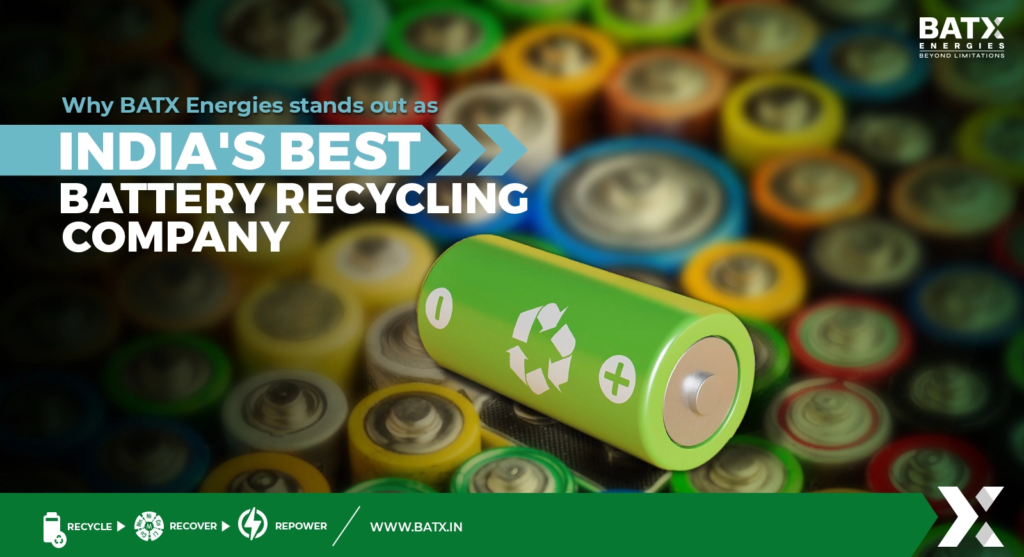From Waste to Resource: BatX‘s Hy-electro process transforms used EV batteries into battery-grade lithium, nickel, and cobalt, giving them a second life and reducing reliance on environmentally damaging mining.
From Used Batteries to Green Gold: BatX’s Hy-electro Technology Transforms Waste into Resource
The burgeoning electric vehicle (EV) and electronics revolution has brought with it a hidden environmental cost: mountains of used lithium-ion batteries. These, if not disposed of responsibly, pose a significant threat to our planet, leaching toxic chemicals and valuable resources into landfills. But amidst this growing concern, a beacon of hope emerges – Indian startup BatX Energies, and their revolutionary battery recycling technology, Hy-electro.
Breaking the Bottleneck: The Growing Battery Waste Challenge
By 2030, it’s estimated that the world will have to grapple with a staggering 11 million tons of spent lithium-ion batteries. Traditional disposal methods, like landfills and incineration, are not only environmentally hazardous but also wasteful, locking away valuable resources like lithium, nickel, and cobalt. This is where BatX steps in, offering a game-changing solution to break the battery waste bottleneck.

BatX’s Hy-electro Revolution: Turning Trash into Treasure
BatX’s proprietary Hy-electro technology is a shining example of innovation for sustainability. Unlike traditional methods that rely on high heat and harsh chemicals, Hy-electro is a clean and efficient hydrometallurgical process. Here’s a breakdown of how it works:
- Mechanical Separation: First, used batteries are shredded and dismantled to separate different components like plastic, aluminum, and the battery cells themselves.
- Hydrometallurgical Extraction: The battery cells are then treated with a specially formulated water-based solution that selectively dissolves the valuable metals – lithium, nickel, and cobalt.
- Electro-winning: Finally, an electrochemical process further purifies the extracted metals, resulting in battery-grade material ready for reuse.

Hy-electro’s Key Advantages:
- High Recovery Rates: BatX boasts an impressive recovery rate of 95% for lithium, 98% for nickel, and 99% for cobalt, maximizing resource utilization.
- Sustainable and Clean: The water-based process significantly reduces energy consumption and minimizes harmful emissions compared to traditional methods.
- Circular Economy Champion: By recovering valuable metals, Hy-electro promotes a circular economy for batteries, reducing reliance on virgin mining and its environmental impact.
From Vision to Reality: Scaling Up and Fueling Innovation
BatX’s recent $5 million pre-Series A funding round, led by Zephyr Peacock and LetsVenture, marks a significant milestone in their journey. This investment will fuel their ambitious plans to:
- Expand Footprint: BatX aims to establish a nationwide network of recycling facilities across India, catering to the growing demand for responsible battery disposal.
- Logistics Revolution: Building a robust reverse logistics network is crucial for efficiently collecting used batteries. BatX’s investment will be strategically directed towards achieving this objective.
- R&D for the Future: Continuous innovation is key to staying ahead of the curve. BatX plans to utilize the funding for further research and development, optimizing Hy-electro and exploring its potential for recycling batteries from other applications.
Beyond India: A Global Catalyst for Greener Solutions
BatX’s success isn’t just an Indian story; it’s a global call to action. Their achievement sends a powerful message to investors and entrepreneurs worldwide – sustainability is not just a buzzword, it’s a profitable and impactful business opportunity. This shift in priorities paves the way for a future where green solutions take center stage, tackling environmental challenges head-on.
Analysis of Lithium-ion Battery Recycling: Traditional vs. BatX’s Hy-electro
| Factor | Traditional Methods | BatX’s Hy-electro |
|---|---|---|
| Environmental Impact | High: Energy-intensive, produces emissions and harmful byproducts. | Low: Water-based, minimizes energy consumption and pollution. |
| Recovery Rates | Varies, often low (70-80% for lithium). | High: 95% for lithium, 98% for nickel, 99% for cobalt. |
| Process Efficiency | Complex, multi-stage with high heat requirement. | Simpler, streamlined with lower energy needs. |
| Resource Recovery | Limited focus on recovering all valuable metals. | Maximizes resource recovery of lithium, nickel, and cobalt. |
| Circular Economy | Minimal contribution, relies on virgin mining for new batteries. | Promotes a closed loop, reducing reliance on mining and waste generation. |
| Capital Investment | High upfront costs for infrastructure and equipment. | Lower initial investment, potentially more scalable. |
| Scalability | Limited, often geographically restricted. | High potential for widespread adoption and expansion. |
The Road Ahead: Charging Towards a Circular Economy
While BatX’s journey is inspiring, challenges remain. Raising awareness about proper battery disposal among consumers and businesses is crucial. Additionally, developing standardized regulations and policies for battery recycling is essential to create a level playing field and encourage wider adoption. Despite these hurdles, BatX’s potential impact is undeniable. They can:
- Reduce environmental pollution: By diverting batteries from landfills and recovering valuable resources, BatX can significantly reduce the environmental footprint of the battery industry.
- Create Green Jobs: The expanding recycling sector presents exciting opportunities for green job creation, boosting local economies and contributing to sustainable development.
- Drive a Circular Economy: BatX’s success paves the way for a future where waste becomes a resource, and batteries have a second life, minimizing our reliance on virgin materials and closing the loop on the battery lifecycle.
ALSO READ :-Zomato’s $2 Billion Shiprocket Bid: A Deep Dive into Logistics Power Play
Stay updated with the latest in the startup world through our Startup News and Funding Alert. Sections. Explore Founder Profiles, Startup Profile, Founders Interview, Success Stories. In-depth Insights articles, Resources, and How to.
For regular updates follow us on